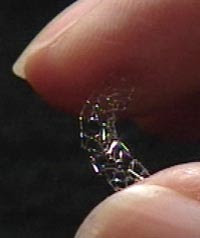Morice, Marie-Claude at el. The New England Journal Of Medicine. “A Randomized Comparison of a Sirolimus-Eluting Stent with a Standard Stent for Coronary Revascularization” June 6th 2002.
<http://nejm.highwire.org/cgi/content/full/346/23/1773>
This clinical study compared the effects of traditional bare metal stents to a sirolimus eluting stent. The previous post examines the effectiveness of a herapin coated stent, and this article examines a different drug to use in the drug-eluting stents. The sirolimus eluting stent was a relatively new design intended to slow cell growth within the stent that resulted in restenosis. The stent is designed with a polymer coating impregnated with the drug covered by another polymer layer. The stent was designed to release 80% of the drug within 30 days. The subjects were tested for percentage stenosis after 6 months. The drug eluting stents arteries had a greatly reduced amount of restenosis after 6 months. This article was a seminal study- one of the first to show a significant reduction in occurrence of restenosis, the “Achilles heal” of angioplasty and stenting, with the use of a this specific drug, sirolimus, embedded in a delivery polymer.

(http://nejm.highwire.org/content/vol346/issue23/images/medium/03f1.gif)
The experimentation with drug eluting stents represents an important development. It represents the process of finding problems with medical procedures and trying to improve those procedures. Balloon angioplasty helped solve the problem of obstructed arteries. When there were issues with vessel collapse and subsequent acute closure and, metal stents were introduced to solve that problem but were only slightly effection for cell buildup and restenosis. When cell growth and restenosis were still an issue, the drug eluting stent was developed to further address this problem. By the looks of this article, drug-eluting stents were an efficient solution to the issues associated with bare metal stents.
It appears from this article that drug-eluting stents are a more effective solution to the problem of restenosis, and a preferable treatment to the bare metal stents. There was a lower occurrence of adverse effects defined as “death, myocardial infarction, coronary-artery bypass grafting, and revascularization of the target lesion or vessel” in the drug eluting stents compared to the traditional stents. An issue with the report is that it only compares the two groups of patients over 6 months. These stents are designed to be a relatively permanent solution to the arterial obstruction. In order to truly justify the usage of drug-eluting stents over the traditional bare metal stents or even balloon angioplasty, studies must follow the patients for an extended amount of time, even years after the implementation of this biotechnology. This article fits into the current health care debate by examining one of the many drugs to be used in drug eluting stents. The specific benefits and issues with the different drugs will help establish when specific drugs are going to be used. Thus following article also examines sirolimus eluting stents, but over a slightly greater period of time.


Concerning the myocardium. (Myo -muscle cardiac heart) Development of an infarct (lack of blood) in the myocardium characterized by pain similar to that of angina pectoris, shock, heart attack and frequent sudden death (cardiac failure)
ReplyDeleteI recommended TIENS Product for you.
Please visit http://www.tiensshop.com